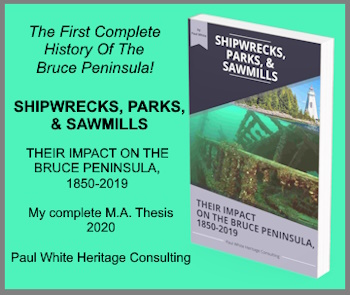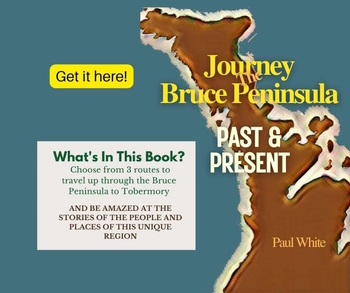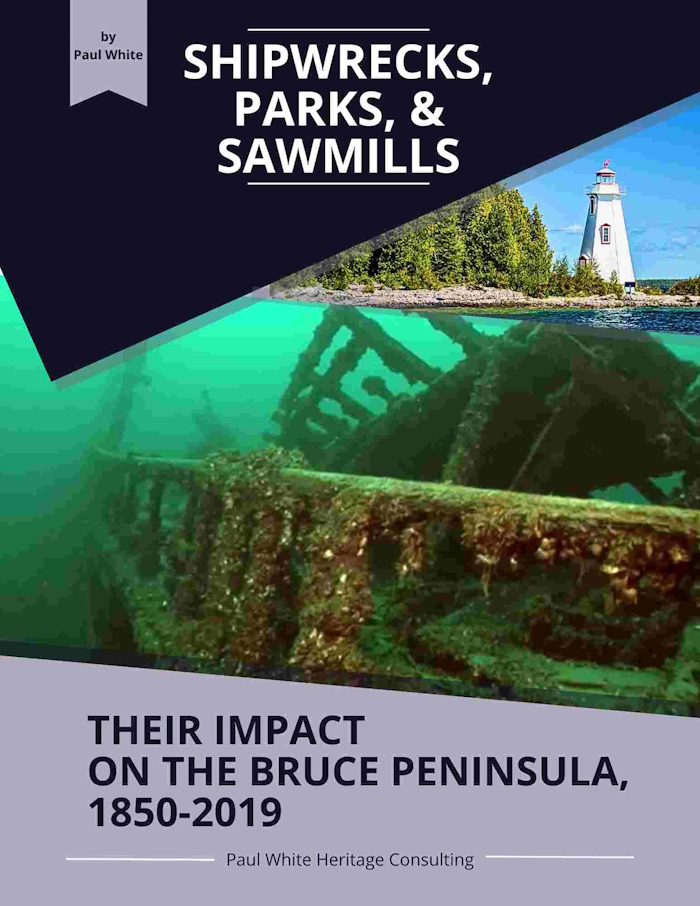Stokes Bay Ontario
A Natural Fishing Harbour
Stokes Bay, Ontario, like most of the Lake Huron communities on the peninsula’s western shore, welcomed fishermen as their first non-native visitors. Today, if you are a fisherman, you will also probably want to try your luck landing a walleye, lake trout, or any of the other game fish that live in the coastal waters off Lake Huron.
In the 1830s, the appropriately named "Fishing Islands" off the shore at Oliphant, south of Stokes Bay, attracted the attention of commercial fishermen from Goderich, Detroit, and other areas.
Stokes Bay’s deep and protected harbour provided safety from the storms that whipped Lake Huron into a deathly frenzy. These factors most likely led to the establishment of a summer fishing village at the present site of the community. Fisherman would set up drying and curing stations along the shoreline, which they would vacate as the onset of winter marked the end of the fishing season.
Although some settlement may have occurred at Stokes Bay, Ontario as a result of these annual visitations by fishing fleets, it was not until 1870 that the area was officially opened to settlement. In that year, the land in Lindsay Township was auctioned for settlement. At the same time, the entire Bruce Peninsula was feeling the sharp edge of the lumbermen’s axes. The depletion of the forests in the French River region had led commercial foresters to the peninsula in their quest to satisfy the needs of a constantly growing market for forest products.
A Deep, Natural Harbour At
Stokes Bay Ontario
The natural harbour with its protection from the fury of Lake Huron storms that had originally attracted fishermen to the area also lured lumbering interests to Stokes Bay. In the 1870s a mill was built on Tamarac Island, a stone’s throw from the mainland.
Tamarac Island rises to a height of thirty to forty feet above the lake level. The mill and its accompanying buildings were located on fifteen acres of land at the north end of the island. The complex included the mill, dock, boiler-house, office, barns, houses and a narrow-gauge tram-line.
Unfortunately, the mill did not prosper. One of the reasons may have been that the mill owner preferred to work with pine, a forest commodity which was not all that abundant in the area. Consequently, the mill was sold. Unfortunately, the new owners were equally unsuccessful and the mill complex was all but abandoned.
Near the end of the nineteenth century, the demand for hardwood for furniture making, led interests to investigate the possibility of re-opening the Stokes Bay mill. In 1899, after much study, the mill was purchased, and operations began, once again.
Land Speculation Entices Business
Sherwood Fox, in his book, The Bruce Beckons, suggested that the quest for hardwood was not the only attraction to the new owners of the mill. Instead, he felt that land speculation was at the root of the purchase. At that time F. H. Clergue, the owner of the Algoma Steel Corporation at Sault Ste. Marie, was promising to build a rail line to Tobermory.
The prospect of the line of steel opening up the Bruce Peninsula was enticing to the new owners due to the fact that the Stokes Bay mill purchase included large parcels of timber land, which once cleared could be sold to prospective settlers.
The proposed railway never happened. But the company cut and sawed the wood in the area and shipped it to Southampton and other points to the south. Ultimately when the stands of wood were cut, the profitability decreased, the mill closed once again.
Today, Stokes Bay, Ontario is a haven for tourists and sports fishermen. Stokes Bay is a great place to spend a warm summer day and then enjoy a romantic Lake Huron sunset.
The information used in this story came from many sources. However, the most important were Norman Robertson’s History of the County of Bruce & Sherwood Fox's book, The Bruce Beckons.
This article originally appeared in my weekly Local History column in the Owen Sound Sun Times.
Enjoy more great stories about the history of the Bruce Peninsula in my book Journey the Bruce Peninsula Past & Present it makes a great travel companion as you travel this unique part of Canada's Great Lakes region.
Discover More About the Bruce Peninsula
Getting to the Bruce Peninsula is a relatively easy driving trip. Here are driving directions from three regions to the peninsula.
Bruce Peninsula Lumber History details the impact of the forest products industry on the development of the region.
Bruce Peninsula Lumbering provided the stimulus to develop and grow the pioneer economy on the newly settled Bruce Peninsula.
Bruce Peninsula Municipal Politics: No matter what the venue, or the issue, seldom is a popular decision made that suits everyone.
Bruce Peninsula Travel Routes were often a matter of debate because in the early years, land travel was virtually unattainable for settlers and lumbermen alike.
Bruce Peninsula winters could be difficult, especially in pioneer times when transportation connections were limited to only a few months each year.
Colpoys Bay Vista - Awesome! A short drive from either Wiarton or Owen Sound is one of the most magnificent views to be found in the province of Ontario!
Forest Products on the Bruce Peninsula contributed greatly to the growth and development of that region of the province of Ontario.
Gillies Lake: aka Ghost Lake has a mysterious past as its original name, Ghost Lake, implies.
Great Grey Owls on the Bruce Peninsula was a surprise discovery for ornithologists and others. Sadly, the story of their visit had an unfortunate conclusion.
Pioneer Campers: Hope Bay mostly considered the peninsula untamed wilderness and some of the locals were not about to disappoint them!
Pioneer Missionary James Atkey arrived on Colpoys Bay to minister to the native community near Oxenden until a treaty uprooted his parishioners.
Pioneer tourists first visited the Bruce Peninsula in the 1800s and the region continues as a great recreational and tourism destination today!
Pioneer Vacations on the Bruce Peninsula got an eerie start in the Hope Bay region of the peninsula.
Lighthouses Lighthouses were vital to Georgian Bay Sailing.
A Flowerpot Island cruise is not only entertaining, but it is also very educational as you will see things that you have never viewed before!
Travel the Bruce: Owen Sound to Wiarton A wonderful journey from Owen Sound to Wiarton.
Travel the Bruce: Wiarton to Tobermory Relaxing and historic journey.
Bruce Peninsula The Bruce Peninsula is a compelling place, with a rich history, to visit. Once you have traveled there, we guarantee that you will return, again and again!





